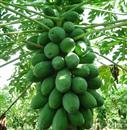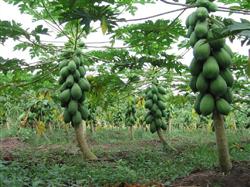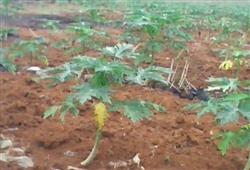Cultivation techniques of Chaenomeles sinensis

Wild papaya is a deciduous shrub or small tree of Rosaceae, also known as Tiejiao pear, papaya and so on. Enjoy the laudatory name of "the fruit of a hundred benefits", can produce beverages, food, health products, medicines, cosmetics, beverages, pigments and other eight categories more than 200 varieties. In recent years, Guizhou Province has gradually strengthened the adjustment of industrial structure and vigorously developed the economy of "green industry" and "ecological agriculture". As an economic fruit tree, wild papaya can not only create high economic benefits, but also play a very important role in returning farmland to forest, maintaining soil erosion and protecting ecological environment. Therefore, the cultivated area of wild papaya has increased year by year. However, due to non-standard cultivation and extensive management, it is left to fend for itself, the yield is not high, the quality is poor, and the economic benefit is low. In order to obtain the high yield of wild papaya, scientific cultivation techniques must be adopted. (1) Wild papaya seedlings are generally raised by cuttings. In late winter and early spring, select the land with fertile soil, loose and deep soil layer, sunny, convenient irrigation and drainage conditions to make a standard compartment of 1.5 color-2 × 3-- 5 meters. About 10 days before cuttage, 10 kg of ripening and leveling was applied according to each standard box. Wild papaya branches with strong growth and high yield were selected as cuttings on young trees. Cuttings were carried out according to the row spacing of 15 cm × 15 cm. The cuttings are 33m long and 66cm long. Pour enough water after insertion and cover the rows with straw. One-step gardening method can also be used: cutting cuttings are directly collected and inserted into the cultivation garden before the wild papaya sprouts, without the need for nursery bed cultivation. The specific operation steps are carried out in accordance with the following planting methods. The twigs of the above two methods can be treated with the medicament 2meme 4fry Djol IBA or potassium permanganate. (2) the site selection and planting wild papaya has strong adaptability, is not demanding to the soil, and can grow on the general soil. However, the cultivation on loose, fertile and well-drained Huizhou acid to neutral sandy loam and loam is the best. It is also suitable for barren mountains and courtyards to grow in a sunny, warm and moist soil environment. Plant after the climate gets warmer in early spring. Generally, 110 plants are planted with a row spacing of 2 meters × 3 meters per mu. The hole nest of 0.7 m × 0.7 m × 0.7 m, each nest was filled with a layer of soil with organic fertilizer 10murmur15kg and then backfilled with 1Mel 2kg of special compound fertilizer for wild papaya. After half a month or so, transplant or cuttage according to one plant in each litter, and water thoroughly after planting. (3) Field management 1, fertilization (1) Fertilizer application amount: according to the seedling condition in the first year, each plant was drenched with fecal water 0.5kg / kg. The annual application of farm manure for adult trees is 15 kg per plant for farm manure, and 5 kg for special fertilizer of papaya. (2) the fertilization period is generally divided into three times. For the first time, 50% of the total amount of base fertilizer was applied at the end of autumn and the beginning of winter. The second time is applied before flowering, accounting for 30% of the total annual fertilization, and the third time in the late stage of fruit growth, accounting for 20% of the total annual fertilizer application; (3) fertilization method: generally, fertilizer is applied into the ditch and covered with soil in a circular ditch at 33m / 66cm from the fruit tree. Foliar fertilizer, such as boron fertilizer, Yemanbao, urea and so on, can also be sprayed on the leaves in the late flowering stage and fruit expansion period. 2. Shaping and pruning wild papaya can reach 10 meters in height and grow into shrub shape without shaping and pruning, which is disadvantageous to management and fruit harvest. (1) plastic surgery: the height of the main rod is 40 murmur80 cm, leaving the center dry. It is divided into two types: upright and curved. The large, medium and small branch groups were cultivated directly on the central trunk. The height of the tree can be controlled at about 2.5 meters, and the crown diameter is about 2 meters. (2) pruning: starting from the fruit of the young tree, the sprouting, withered branches, disease and insect branches, central branches, weak branches, old branches, growing branches and growing branches should be cut off. In order to ensure a certain amount of growth every year, in order to maintain robust growth, we should grasp the principle of updating before decline. The use of robust developmental branches to renew the crown, stabilize the skeleton and maintain the growth advantage of backbone branches. 3. The cultivation land of wild papaya can be intercropped with dwarf crops, such as vegetables, green manure, potatoes and so on. Combine planting crops and fertilizing to weed and turn over the land, turning the land twice a year. 4. Wild papaya has a strong ability to resist diseases and insect pests, as long as pruning and reasonable fertilization are strengthened, it is generally not easy to occur. The common diseases are leaf blight, skin blight, dry rot and so on. Leaf blight and dry rot can be sprayed with a Bordeaux solution of 1 / 2 / 200; skin blight is scraped off vigorously and smoked with sulfur or coated with stone-sulfur mixture. Early damage to longicorn beetles and aphids can be controlled with omethoate and other insecticides. In a word, using the above cultivation methods, the annual yield of wild papaya is stable and there is no difference between big and small years. The annual yield per mu can be as high as 2000Mel 4000 kg, and the quality and appearance quality of the fruit have been improved; at the same time, it can improve the stress resistance, disease and insect resistance of wild papaya.
- Prev

Standardized high-yield cultivation techniques of papaya
Papaya fruit oval, pulp lignified, resistant to storage, natural storage can be up to 5-6 months. The skin is smooth, waxy, golden and shiny; clean and beautiful, rich and unique aroma, placed indoors, aroma overflowing, lasting for a long time. Because there is a layer of mucous membrane on the surface of Yizhou papaya seed, the seedling emergence rate is low.
- Next

Planting and management of Xuan papaya
When the orchard was deeply ploughed in late September, the base fertilizer was mixed with stable fertilizer and human manure and urine, and the available N fertilizer was applied to each young tree with 15kg base fertilizer and 30kg base fertilizer per tree. Topdressing: before sprouting (from late March to early April), 130 grams of urea or 400 grams of ternary compound fertilizer were applied to each plant. Spray 0.3 each 2 weeks before anthesis.
Related
- Moge, come on! The staff of the peasant association in the producing area of cantaloupe were frightened when the crowd gathered.
- Causes and Solutions of low Fruit setting rate of Apple
- Symptoms and control measures of passion fruit virus disease
- Fruit growing lesson: how do apple orchards keep high yields?
- Can you build orchards in the mountains? What are the pros and cons?
- How to manage the coloring period of Crisson grape?
- This paper introduces the processing technology of two kinds of fig products.
- How much is a month for retired teachers in rural areas by 2020?
- How can strawberry planting increase sugar content? We should pay attention to management in many aspects.
- What are the cultivation techniques on how to improve the yield of golden fruit?

